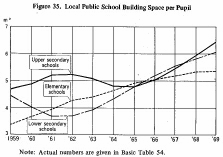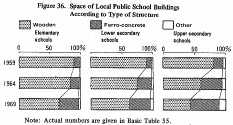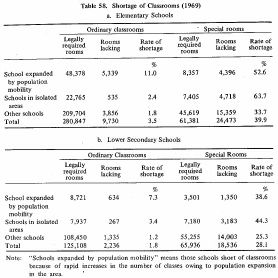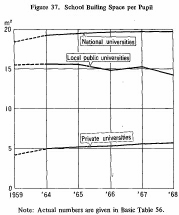| Home > Policy > White Paper, Notice, Announcement > White Paper > EDUCATIONAL STANDARDS IN JAPAN 1971 > CHAPTER |
||
In the two decades after World War ![]() the national and local
governments made all possible efforts to reconstruct the schools destroyed by
the war, to extent they ears of compulsory education, and to meet the shortage
of classrooms caused by the expansion of population in the age group born after
the end of the war. Now in the third decade, since the above mentioned measures
have been accomplished, efforts are centered on the improvement of both ordinary
classrooms and special classrooms on a basis of elevating the standards of required
facilities, constructing new gymnasiums and carrying out other measures to improve
the quality of school facilities.
the national and local
governments made all possible efforts to reconstruct the schools destroyed by
the war, to extent they ears of compulsory education, and to meet the shortage
of classrooms caused by the expansion of population in the age group born after
the end of the war. Now in the third decade, since the above mentioned measures
have been accomplished, efforts are centered on the improvement of both ordinary
classrooms and special classrooms on a basis of elevating the standards of required
facilities, constructing new gymnasiums and carrying out other measures to improve
the quality of school facilities.
With regard to the improvement of facilities of local public schools, in 1969 the school building space per student was 5.34 m2 , 6.09m2, and 6.44 m2 , respectively for elementary schools, lower secondary school and upper secondary schools. This indicates that at all three levels the space has constantly been increased.

Note: Actual numbers are given in Basic Table 54. Basic Table 54

Note: Actual numbers are given in Basic Table 55. Basic Table 55
As to the construction of school buildings, there are "wooden", "ferroconcrete" and "other" buildings. In 1969 wooden buildings accounted for 63%, 58%, and 40% respectively for elementary, lower secondary, and upper secondary schools. Comparing this with the figures of 10 years ago one observes that wooden buildings have very rapidly decreased and been replaced ferro -concrete buildings. Nevertheless in spite of this improvement some problems still remain. For instance in overpopulated areas the shortage of classrooms is obvious, and obsolescent buildings amount to l4.9%, 8.5% and l4.6% of the wooden buildings in elementary, lower secondary, and upper secondary schools respectively.
There are provisions in the Law Concerning Class-size and the Standard of Fixed Number of Educational Personnel with regard to the standard size of classes, but in reality the construction of buildings has not reached' these standards. There is a shortage of 10,000 ordinary classrooms for elementary schools and 2,000 for lower secondary schools. This represents 3.5% and l.8% of the total required ordinary classrooms of elementary schools and lower secondary schools.
There is a shortage of 24,000 special types of classrooms such as science rooms, music rooms, art rooms, homemaking rooms, and vocational rooms in elementary schools, and 18,000 in lower secondary schools. Most schools have science room sand music rooms, but not many schools have art rooms, homemaking rooms or vocational rooms. Looking at the shortage according to differences in area, i.e. areas with expanding populations, isolated areas and other areas, one notes that the shortage of ordinary classrooms in the areas with expanding populations is a serious problem. In these areas there is an l l.0% shortage of ordinary classrooms in elementary schools and a 7.3% shortage in lower secondary schools. About 10% of the need in these areas is being met with prefabricated tentative buildings or gymnasiums and special rooms tentatively remodeled.
In order to solve this problem the government began its third five-year plan for improving local PL1bl1C educational facilities in 1969, and is trying to overcome the shortage by putting special emphasis on the shortage of classrooms in the overpopulated areas.
Table 58. Shortage of Classrooms (1969)

National, local public and private universities have all greatly increased their ownership of buildings. But as enrolment has increased the space per student has only marginally improved. As of l969the space per student was 19.5m2, 14.2m2,and 5.7m2 respectively in national, local public and private universities. The figure for the private universities is only about one quarter that of the national universities.

Note: Actual numbers are given in Basic Table 56. Basic Table 56
In other major countries in order to meet the extension of the years of compulsory education and the increased enrollment in higher educational institutions efforts are being made to expand school buildings at the elementary, secondary and higher educational levels.
In the United States the Elementary and Secondary Education Act of 1965and the Higher Education Facilities Act of 1963 allowed the Federal Government to give subsidies to improve the facilities and equipment of elementary and secondary schools in areas with large concentrations of poor families, and to both public and private universities.
In England and Wales the new construction of school buildings in areas with rapid expanding population, the replacement or remodeling of obsolescent school buildings, and the new construction or enlargement of school buildings to meet the need for reforming secondary education into a comprehensive style are all being undertaken with great emphasis.
In France the Sixth Five Year Plan was made for the improvement of facilities in order to meet the expansion of education resulting from both the extension of compulsory education and the expansion of enrollments in higher educational institutions.
In Germany and the U.S.S.R., efforts are being made to integrate the small sized elementary. schools in rural areas.
In addition to the expansion and improvement of facilities mentioned above, as seen in chapter two, completely new types of classrooms are appearing as new educational methods and structures are being introduced.
| Back to Top | MEXT HOME |